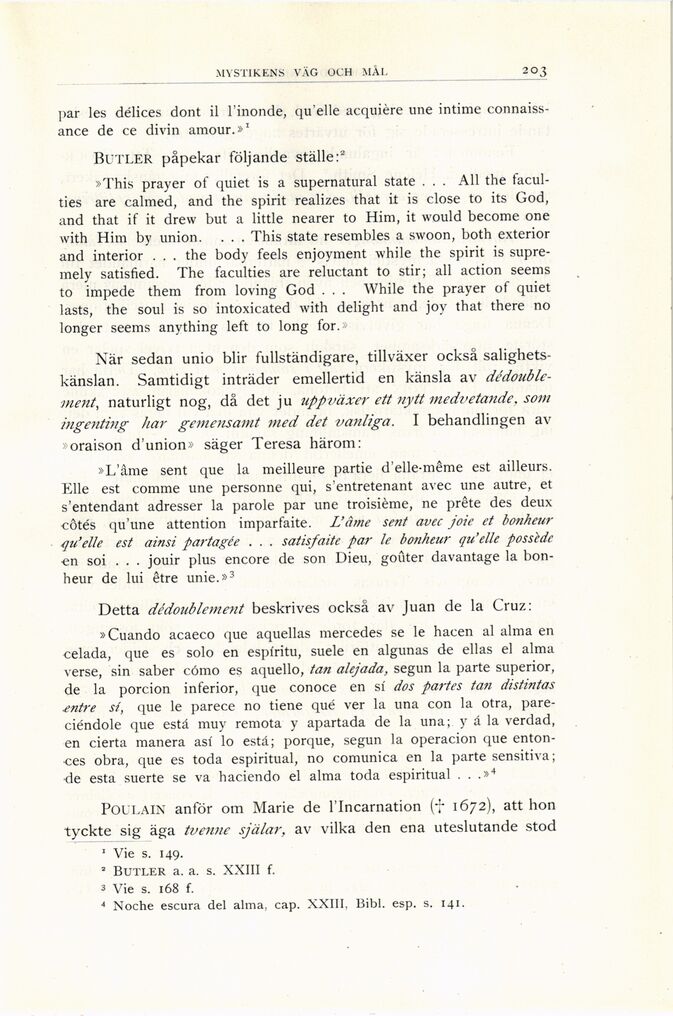
Full resolution (JPEG) - On this page / på denna sida - Sigurd Lindquist, Mystikens väg och mål - II. Det mystiska tillståndet och dess innehåll - C. Mystikens mål: unio mystica

<< prev. page << föreg. sida << >> nästa sida >> next page >>
Below is the raw OCR text
from the above scanned image.
Do you see an error? Proofread the page now!
Här nedan syns maskintolkade texten från faksimilbilden ovan.
Ser du något fel? Korrekturläs sidan nu!
This page has never been proofread. / Denna sida har aldrig korrekturlästs.
MYSTIKENS VÄG OCH MÅL 2 o 1
par les délices dont il l’inonde, qu’elle acquière une intime
connaiss-ance de ce divin amour.»1
Butler påpekar följande ställe:2
»This prayer of quiet is a supernatural State . . . All the
facul-ties are calmed, and the spirit realizes that it is close to its God,
and that if it drew but a little nearer to Him, it would become one
with Hirn by union. . . . This State resembles a swoon, both exteriör
and interiör . . . the body feels enjoyment while the spirit is
supre-mely satisfied. The faculties are reluctant to stir; all action seems
to impede them from loving God . . . While the prayer of quiet
lasts, the soul is so intoxicated with delight and joy that there no
longer seems anything left to long for.»
När sedan unio blir fullständigare, tillväxer också
salighetskänslan. Samtidigt inträder emellertid en känsla av
dédouble-ment, naturligt nog, då det ju uppväxer ett nytt medvetande, som
ingenting har gemensamt med det vanliga. I behandlingen av
»oraison d’union» säger Teresa härom:
»L’ame sent que la meilleure partie d’elle-mëme est ailleurs.
Elle est comme une personne qui, s’entretenant avec une autre, et
s’entendant adresser la parole par une troisième, ne prëte des deux
cötés qu’une attention imparfaite. L’ame sent avec joie et bonheur
qu’elle est ainsi partagée . . . satisfaite par le botiheur qu’elle posside
•en soi . . . jouir pius encore de son Dieu, goüter davantage la
bonheur de lui ëtre unie.»3
Detta dédoublement beskrives också av Juan de la Cruz:
»Cuando acaeco que aquellas mercedes se le hacen al alma en
celada, que es solo en espiritu, suele en algunas de ellas el alma
verse, sin saber cömo es aquello, tan alejada, segun la parte superior,
de la porcion inferior, que conoce en si dos partes tan distintas
£ntre si, que le parece no tiene qué ver la una con la otra,
pare-ciéndole que estå muy remota y apartada de la una; y å la verdad,
en cierta manera äst lo estä; porque, segun la operacion que
enton-ces obra, que es toda espiritual, no comunica en la parte sensitiva;
-de esta suerte se va haciendo el alma toda espiritual . . ,»4
Poulain anför om Marie de 1’Incarnation († 1672), att hon
tyckte sig äga tvenne själar, av vilka den ena uteslutande stod
’ Vie s. 149.
3 Butler a. a. s. XXIII f.
3 Vie s. 168 f.
4 Noche escura del alma, cap. XXIII, Bibi. esp. s. 141.
<< prev. page << föreg. sida << >> nästa sida >> next page >>